Sending this to Yeastspotting.
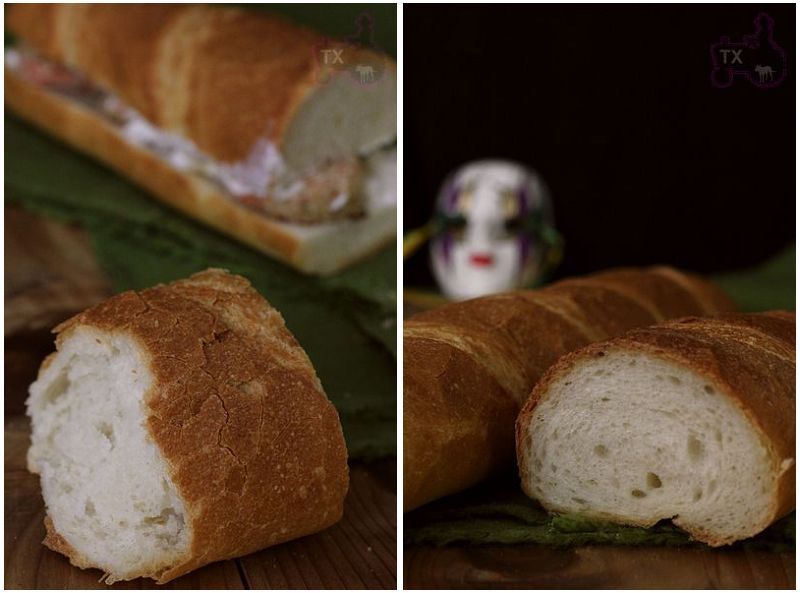
Honestly, I do blame it on Eric. Firstly, he posted a mouth watering blog about his initial attempt at replicating the famous NO French bread (see here); then he emailed me and asked me to do futher investigation; just to make it final, he even fowarded me some links and pictures to get me started. After a few tries, my final version actually is not that different from Eric's original formula, with the following modification:
- To make crumb velvety soft
* Knead, knead, and knead, see this post for details. If your bread is too dense, too tough, knead more.
* Some enriching ingredients like sugar, powdered milk, and fat. However if there are too much enriching ingredients, the crust will become soft too. Eric's original formula provides a good balance.
* I used a combination of AP and Bread Flour. BF is there to ensure enough strength, so the bread can have a lot of volume, thus guarantee a soft mouthfeel, as well as some "bounciness". AP flour is used to add tenderness. You can certainly adjust the AP/BF ratio to get the crumb you like.
- To make crust very thin and crispy
* 10% of rice flour. I have made baguettes with rice flour before with very good and crispy crust, it does the same thig here.
* Bake with steam (Eric's version does that too).
* Brush the dough with liquid before baking. I tried different liquid with different results: cold water -> thin, crispy, probably the most "authentic" version; egg whites/corn starch+ water -> even crispier than water but thicker; olive oil -> still crispy but less crackly, very fragrant, my favorite
* Size matters. I tried to make them smaller, but the baking time ended up too short to create a very crackly crust. If the size is too big, crust would be baked too long , which means too thick. The size I am making below is smaller than Eric's original version, but still big enough to get the crust right.
New Orleans Po-Boy French Bread (adapted from Bernard Clayton's "New Complete Book of Breads")
Note: makes 2X400g loaves
Bread Flour , 225g
AP Flour, 150g
Rice Flour, 45g
Water, 300g
Instant yeast, 1.5t
Salt, 8g
Sugar, 10g
Powdered Milk, 5g
Butter, 10g, softened
1.Mix everything but butter, knead until gluten starts to form, add in butter, knead until pass windowpane test, see this post for details. Note that rice flour is pretty coarse, may interfere with gluten formation, so the kneading would take a while, and the windown pane would be a bit thick.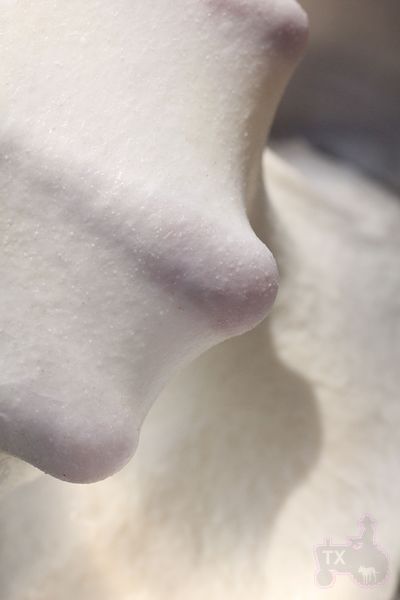
2. Bulk rise at room temp (75F) for 70min until more than doubled, S&F at min 50.
3. Divide into 2 parts, preshape and relax for 20min. For each dough, roll out to 14X6inch, get rid of all air bubbles, roll up, seal, roll out to 16inch in length.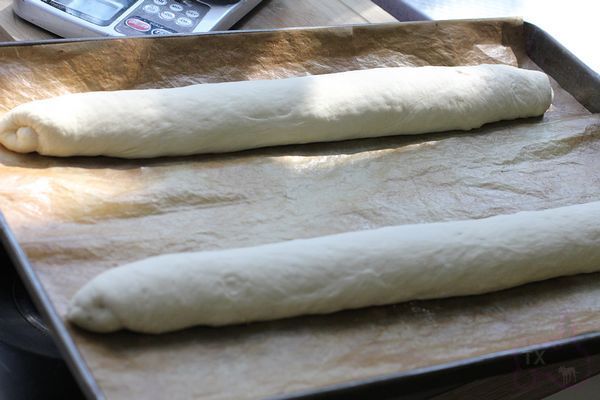
4. Proof at room temp until double, 45min to 60min. Brush with water (or other luqid), score.
5. Bake at 425F for 20min with steam, lower to 375F, rotate baking sheet, and keep baking for another 20min. The last 5min with door cracked open.
Very crispy and crackly crust, crumbs everywhere when cut or torn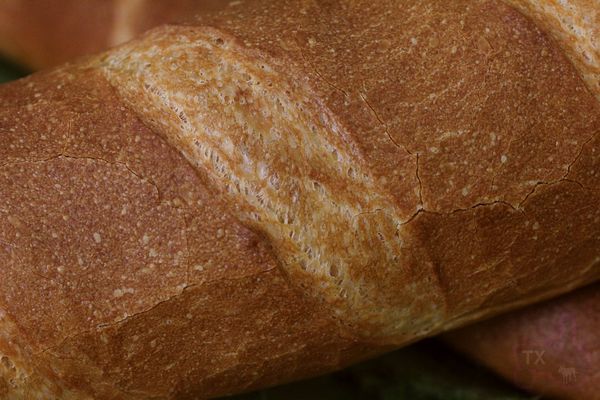
Crumb is velvety soft and shreddy, I could pull the inside out like this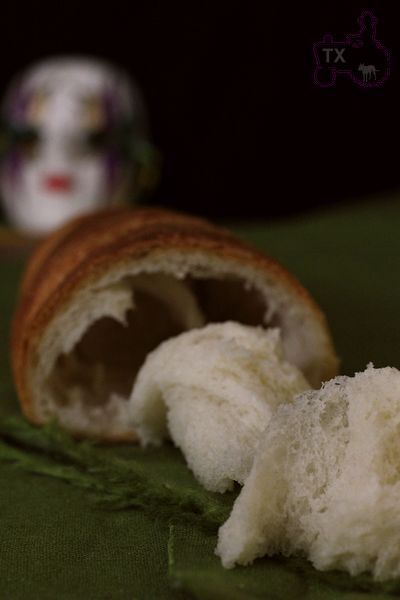
I know the most popular Po-Boy sandwich is pulled pork/beef, but I love fried shrimp filling. This time I just rolled shrimps in bread crumb, then baked until done. Equally delicious.
- txfarmer's Blog
- Log in or register to post comments
Is that yeast amount right; 1.5 Tablespoons?
Should be teaspoon, I've changed it, thanks for pointing it out!
Thanks.
Well done, by the way. They look delicious.
I'm so glad you took the bait and took this bread up. As so often is the case, the bakers technique is 90% of the final product. I like what you did here with the rice flour addition. Your crust does seem thin and crispy. Did you try a lower heat for a lighter crust color? I know you like a bold bake but I'm wondering if it come back a touch. Maybe reduce the sugar by a gram or two? It looks very good txfarmer. I figured you would be the perfect person to give it a try with all your recent success making soft crumb breads.
Thank you so much for working on this bread. There are lots of folks who have tried to create the perfect Po-Boy style breads and it's a tough one to duplicate. Oyster is my favorite. I'll give this a try soon and I hope some other N.O. fans will also.
Eric
Hey Eric, I have your original blog/formula to thank for a good base recipe. For a lighter color I may bake a couple minutes less. I wouldn't cut back on sugar, might even double it next time for flavor. That might just be my Asian taste buds talking though - I am used to slightly sweeter soft breads, even for savory fillings.
I plan to make a sourdough version next, with slight adjustment on sugar/milk powder/etc., must try another filling too!
Looks great txfarmer! Thanks for tackling this one. I appreciate the thoughtful analysis in your mods writeup. I'm looking forward to trying this recipe.
Thanks! Hope you'll like the result!
Oh, that is a great crust and just when I was contemplating other breads I get distracted by this post. It happens all the time on this site. I will be happily planning and researching my next bake when, wham... a post like this comes along and I get thrown off direction. I need to concentrate and not be so easily swayed! Perhaps it is because I am a Gemini. (Not that I profess to know much about - or care for - that kind of thing but it's what friends have told me anyway)!
Ha, I often get sidetracked too. This one doesn't take a lot of time, so hopefully it will be a quick one to tackle.
You nailed this one txfarmer, as far as I'm concerned. I had to make this one right away.
Although I have never had any real PO Boy bread, this is a great light, fluffy, crispy sandwich roll. Mine came out almost just like yours, sans the perfect scoring and shaping. They sang for 15 or 20 minutes after removing from the oven, and theres shards of the flakey crust all over the place after eating a sandwich. Even though I have to hand mix, the dough was just lovely. About the bounciest dough I've made yet. The loaves spring up nice and round, almost as if baked in a baguette pan. I made three 11" rolls. I must admit I've been a little leery of using rice flour, but it worked out great.
This ones a keeper for me. Thanks to you and Eric.
By the way, I also made a yeasted, buttermilk version of your soft rye sandwich loaf, and it to was great!
Excuse the poor pictures, as at the moment I only have an old, cheap web cam for pictures, but I just had to take some. They are not nearly as pale as they look here, but I like them just a little lighter than some.
Very nice! They look great, can't believe you made them so quickly!
Lovely, Txfarmer! just the kind of bread i used to eat as a child.. No chemicals in this one, though.. just true bread..!
Wonderful crumb, and crust, as usual!!
Thanks Mebake!
Txfarmer! I noticed that you didn't use hot water as specified in Eric's recipe (120°-130°F). I wonder if such a hot water gelatinizes a part of the flour and what influence it can have on the final crumb.
I have seen a lot of methods that uses hot water to soak part of flour, which does make the crumb softer. One example is the "汤种”(soup seed) method that's popular in Asia. HOWEVER, after many experiments, I think it's simply a shortcut to kneading. If you knead the dough to perfection, the crumb will be just as soft, even without the hot water. In addition, a dough that's kneaded well VS. a dough that's not kneaded well but uses a hot water soaker, the former will be soft AND have a larger volume and bouncy/fluffy mouth feel, the latter would be soft, but just that. Just my personal experience.
Txfarmer, specifically(brand), what do you use for scoring your dough?
Thanks.
Double edge shaving blade. Sometime on a stick, but I have lost the stick, so just a blade. Brand? Uh... Walmart or some other grocery stores? :P
Thanks. That is what I use too. But not nearly as skilled as you.
Your baguettes remind me of those soft and fluffy baguettes they sell at marketplaces. Of course, yours look and probably taste 100x better than the chemical laden baked sticks. I always wondered why they were labelled as baguettes when the so called baguettes looked more like sandwich bread in stick shape.
Ha, I refuse to all these "baguette". I have baguette formulas I stick to (here), and they are completely differently from these NO breads. Both are delicious, but different.
txfarmer, I get total ingredient weights of 760g, so your loaves are closer to 380g each not 400g each, just to be picky ;)
planning to try it out this evening.
You are correct, I admit I was giving a "rough" number. :)
So I'm in the process of making this right now...got a few questions:
1. What is the feel of the dough you're going for? I used 100% bread flour (my plain vanilla store brand) in place of the AP+bread flour, and it was incredibly sticky while kneading; it was just a little beyond a batter!. Not a surprise to me, given the hydration is 71%. I added probably 1/3c. more flour to get it to come together, in a ball, and even with that, it didn't clear the sides of the bowl. Should the kneaded dough be tacky & not sticky? I kneaded it in my KA with the dough hook at speed #3 for about 17 minutes, got decent windowpane but not nearly as silky and smooth as the one in your photo. Still, the dough felt supple when I did the S&F on a lightly floured surface.
Am I correct to assume this means "bulk rise for 50min @ 75F, S&F, and continue to rise for 20 more minutes, until more than doubled (70 minutes total)"? My dough had almost doubled at 50min @ 75F (covered in a plastic bucket) before I did a S&F, and it took about 1 hr for it to double again. Can you clarify what you are going for here?
1. The dough starts out wet but should become silky after kneading. It should clear the bottom and sides fo the mixing bowl. I would suggest to autolyse for a while then knead. You can certainly add flour, but in my experience, a wetter dough leads to a softer/tender crumb, IF well kneaded.
2. If the inital volume is V after kneading, after 50min, it should nearly double (2V), after S&F (to redistribute yeast for a fuller bulk rise), it shouldn't go back to be V, should be 1.2-1.5V. Then after another 20-25min, it should become 2V again. If yours took another 1 hour to double again, it's not right. My guess is that the dough was not kneaded enough.
Thanks txfarmer. I think the autolyse would help, I will incorporate that step the next time (I didn't see it in your original recipe so I didn't do it); do you always autolyze your doughs?
Thanks for the volume clarification; I will try kneading longer. It did end up doubling, as I said, but it took an hour. When I did my S&F, I degassed substantially, and the volume was probably 1.2V.
Still, it turned out very well. I like the buttery aroma and flavor in the crust. It was the most "shattery" crust that I've ever been able to achieve, although what I'm aiming for would be a little more "flakes" and a little less "dust", but this recipe is leading me in a better direction. I'm wondering if shortening or lard in place of the butter would help contribute to that, assuming that the butter/shortening effects work similar to pie crust (butter = good flavor but "dusty", shortening = no/greasy flavor but flaky).
Your instruction on the intensive knead have been invaluable, and have definitely increased my confidence with my KA and knead times. Historically I've worried about over-kneading but I think I'm realizing that's quite difficult to do with the KA. Now that I know I can knead for 15min at speed 3 without the dough breaking down, I am more willing to push knead times. Based on the hydration/stickiness issues I was having, I only had a rough windowpane at 13 minutes or so, I ran it for about 17-18 minutes total, and the windowpane was still not nearly as smooth as what you showed in your photos. The crumb was very white, soft, light with a very mild flavor, I'm sure due to this intensive knead.
So more learning, more testing, and thanks again for the great recipe!
txfarmer, thinking about the wetness problem I had with the recipe suggests to me that you may have different results because you specified "bread flour" in your formula and not a specific brand & "model".
Absorption rates can vary wildly among different kinds of flour, depending on gluten levels and other properties, so while your 71% hydration might be just right, my 71% hydration with different brands of flour may be much too wet.
If you'd be willing to share, what kind of flours (bread and AP) do you usually use for this?
King Arthur BF and AP is what I use. BTW, I am "infamous" for liking wet dough, so you might indeed have to adjust hydration to be comfortable with the dough.
txfarmer--wow! These look great; excellent work.
I've been struggling with this bread type off and on for about a year and still can't quite get it like Leidenheimer's in NOLA. The biggest issue is that theirs is about 1/2 as dense as what this recipe produces--I'm basing that on the calories, as one of their 6" loaves is about 2 ounces/56g and contains 150 calories:
http://www.leidenheimer.com/facts.htm
The Clayton recipe we're using as a base and your variant are more like 300 calories and 85g for a 6" loaf. I've had limited success by being very careful in my proofing and shaping--maybe 1 time out of 5 it came close to the 1.5" height and 3" width of the real stuff with the Leidenheimer lightness, but it's been hard to duplicate.
Any thoughts?
I did find this recipe online, which has given me the correct rise on occassion. I was going to work on the crustiness of the exterior, but wanted to get the rise and interior texture down first.
Here's an exterior shot; sorry--no interior and hard to judge exterior in this picture. BTW--I've noticed that po-boy loaves tend not to be split crusts; they have smooth tops.
Bánh Mì / Po-Boy Loaves
Makes (3) 16-inch baguettes
Ingredients:
Instructions:
Mix the yeast, sugar and water together and let sit for 10 minutes.
Add the flour, salt, butter and oil and mix until you have a soft dough (about 6-8 mins on med-low with dough hook in stand mixer). Form into a ball, coat with oil and let rise in a warm place until doubled.
Punch down, knead for 3-5 minutes, form into ball, and cover and let rest for 5-10 minutes.
Shape into:
Preheat oven to 460°F, place a spare pan for steam on the bottom, and have 1 cup of boiling water ready.
Cut slashes into each loaf (optional), sprinkle with salt water and place in oven. Pour boiling water into a pan in the oven for steam and quickly shut oven door. Bake until golden, about 12-18 minutes.
Remove from oven and let cool.
From:
http://bepnha.wordpress.com/2010/06/18/banh-mi-cho-ngay-hom-nay/
And finally here's a shot of Leidenheimer's bread (fried chicken po-boy with white gravy...yum!). You can see how loose the crumb is; it's more air than bread! And the crust is relatively thin and crackly--it flakes, rather than shatters, and is easy to bite into.
I have a cookbook ("The New Orleans Cookbook" by Rima and Richard Collin) with a recipe for New Orleans French bread and wanted to share a little bit from it. First let me say that this cookbook is as authentic as they get. I can't type the whole recipe because it takes up 2 1/2 pages but I will share some of it. First off, the ingredients are different from what yall are using - they don't really enrich the bread at all.
The recipe calls for yeast - 1 1/2 oz fresh compressed yeast or 3 packages active dry, 2 tspof sugar, 4 tsp salt, 1/2 water (for proofing the yeast and making a sponge), 5-6 cups bread flour, 1/2 tsp Arkady yeast food, 2 tsp crisco, 1 1/2 c warm water, and 1/3c cornmeal for dusting. There's no milk or eggs or anything heavy like that. They make a bit of a sponge to start but other than that the procedure for making the dough is pretty straight forward. They add warm water and flour is 1/2 c increments to pull the dough together until the dough gets stiff, adding the last remaining cup of flour as needed during the kneading. They do stress that the dough must be perfectly risen when baking - not overrisen or they won't be as light and puffy. They preheated an oven at 475 F with an iron skillet filled 2/3 of the way with water (left in the whole time during baking) on the bottom of the oven. (the skillet is in the oven during preheating). Before putting the loaves in the oven they are brushed with cold water. Bake on middle rack. After 5 minutes of baking they are sprayed or brushed again with cold water. Bake another 20 minutes until loaves are brown and crisp. Cool on cake racks. To serve, heat in a 400 F oven for 5-6 mins.
I live about an hour away from New Orleans and love, love LOVE a poboy. On a side note, if you do want to make a shrimp poboy (which I highly recommend!) please dredge the shrimp in cornmeal before frying (with Tony's seasoning or other awesome cajun seasoning blend - I have a good homemade recipe if you are interested) and NOT bread crumbs. I have never ever eaten fried shrimp that way - it just sounds wrong:) Add shredded lettuce, tomatoes, and lots of mayo and you've got the real deal.
[quote=jbaudo]On a side note, if you do want to make a shrimp poboy (which I highly recommend!) please dredge the shrimp in cornmeal before frying (with Tony's seasoning or other awesome cajun seasoning blend - I have a good homemade recipe if you are interested) and NOT bread crumbs. I have never ever eaten fried shrimp that way - it just sounds wrong:) [/quote]It doesn't just sound wrong, it is wrong. :blech: Save the bread crumb and flour breading for chicken, veal and veggies.
All fish and shellfish should be breaded with cornmeal (plus a little salt and pepper). I do know of some who will use hominy grits, but I think hominy can over-power some of the more neutral flavored fish. For shellfish, of which I am not a great fan, additional seasoning is OK because of their stronger flavors. I prefer to simply use dried jalapeño flakes.
cheers,
gary (an old suthren curmudgeon)
I just came across this blog string so I am not sure if anyone is still following, considering the post date. I live in New Orleans (NO) and have for most of my 68 years. Leidenhemer is today the only remaining commercial baker of French Bread(FB), but prior to 2005 (H. Katrina) there were several commercial producers in the metro area. Reising Sunshine Bakery and Binder Bakery were next in line after them. Personally I did not care for Binder's crust as it was almost powdery when you bit into it and the crumb was too dry for my taste. Reising was my favorite as the crust was crisper and the crumb was finer and more pillowy than Leidenheimer. I use to bake bread at LeRuth's Restaurant, as like Antoine's in the French Quarter, we made our own FB daily. All had the classic NOFB characteristics of very thin, crispy/shatery crust and soft billowy crumb, and all had a general blonde to light tan crust. The blonder crusts were usually seen at the restaurants as they would reheat or toast the loaves just prior to serving. I had truly never noticed, until it was pointed out above, that Leidenheimer FB is generally not scored, at least not on top. upon close examination of loaves today there may be scoring taking place on the sides. My main point in posting is your reference in "The New Orleans Cookbook" recipe for Arkady. The recipe use used at Le Ruth's also called for Arkady and I recall Chef Warren saying it was a critical additive to getting the desired crust and crumb. Unfortunately this product is no longer available as the FDA had it banned because it was a brominated product and Bromine is associated as possible carcinogen. I have been searching for an alternative for years as the recipe does not product the same quality of bread without it.
I've been lurking here at the fresh loaf for a long time, but this bread inspired me to finally sign up and comment. I've been trying to recreate NOLA French Brench forever with little success. While this isn't and exact replica of those delicious, nearly insubstantial, shattery breads. It is delicious and by far the closest I've come. I think the rice flour definitely made a difference in the crunch.
My first attempt did not come out exactly like the pictures. It think I need a new scale. It does well with ounces, but isn't sensitive enough in grams. Although, the instructions deny it, I've only been able to get the numbers to move in five gram increments. Consequently, my dough was too wet for proper shaping. It just lay in an approximately torpedo shaped puddle on the baking sheet and couldn't begin to be slashed. Still, it baked up nice and light with a lovely flaky crust. I will be using it for Bahn Mi today, and definitely trying it again soon. Thanks so much for sharing your super recipe!
CT
i don't know if people are still responding to this thread but I just had to say thanks! I'm a NOLA transplant in Brooklyn and just started breadmaking in an effort to recreate great French bread like Leidenheimers. I've only used a breadmaker because I was afraid of kneading. I'd attempted breadmaking years ago and made brick after brick so I thought having the bread maker do the kneading would do the trick. Wrong! In any event, this was my first attempt doing it all on my own and it came out great!!! Your advice on kneading was so helpful and now I feel like I've "gotten to know" the dough in a way I never would have with the bread maker. And I have awesome French bread! So thanks again. Off to the store to get some shrimp for po boys for dinner!
Stephanie
Has anyone used a poolish or sponge with this recipe? Has anyone tried a sour dough version? If so, comments and suggestions would be appreciated.
Periodically I stalk this thread.
I’ve made this bread, and it’s very very good.
I’m just wondering if there have been any changes or improvements.
This is the closest recipe I’ve found to the authentic thing itself.
I don't visit this site too often but enjoy it when I do. Like many in this thread, I'm searching for the unicorn-the reproducible recipe for NO po-boy bread. I've spotted him occasionally but he usually runs off. Anyway, couple questions from txfarmer's edits at the top:
1. i'm not a baking novice but not sure what "S&F" is--"shaping and finishing"? "stretching and folding"?
2. not sure what txfarmer means by "10% of rice flour"-does that mean 10% of what's called for in the recipe, i.e. 4.5g=10% of 45g or 10% of the total flour, 225+150=375 X 10%=37.5g of rice flour?
Thanks for your help.
1) S&F: stretch & fold, or occasionally, slap & fold--a different technique.
2) txfarmer probably meant 10% by baker's percentage of the flour. As you noted, 45g doesn't work out to 10% (it's 12%). I imagine she tinkered with the recipe and forgot to change the 10%.
So, have you tried this recipe?
Thanks. I figured out the "S&F" either by a little time with Google or another bread source I have-should have figured it out anyway.
I did try the recipe and is the closest I've come to Leidenheimer po-boy bread yet after many years of trying. I'm hanging on to this recipe for sure. Thanks for the check-in.I live in New Orleans and I will try this and also keep an eye on this thread.
V